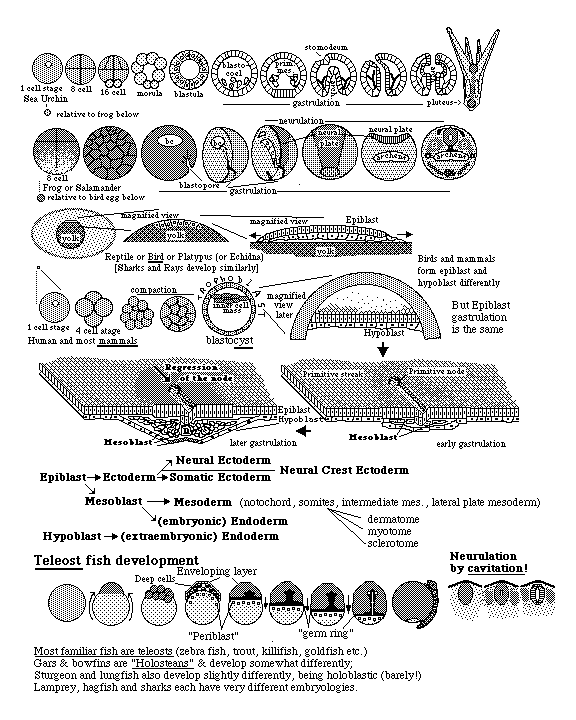
In bird, reptile & mammal embryos, before gastrulation two layers of epithelial cells have been formed.
The epiblast is the upper=outer layer; the hypoblast is a thinner layer under it (next to yolk in birds).
Next, an elongate thickening of epiblast forms called the "primitive streak" : (this will be body axis).
Along midline of primitive streak, ingression occurs along line, "primitive groove" instead of blastopore.
Those epiblast cells that undergo ingression, after they have ingressed, are called "mesoblast cells"
The mesoblast cells crawl laterally to either side: most of them will form mesodermal organs
But some mesoblast cells insert themselves into the hypoblast & become part of it;
The hypoblast forms endodermal organs, (stomach, intestine, lungs, liver etc.)
Those epiblast cells that never undergo ingression and are left behind at the surface become ectoderm.
The anterior end of the line where ingression occurs is called the Hensen's node or Primitive node
---->> This node corresponds to the anterior or head end of the body that is being formed <<----Ingression pregressively ceases, anterior first, etc. so that Hensen's node seems to move
The mesoblast/mesoderm cells to either side of the notochord segment into pairs of somites:
Each somite subdivide 4 parts: dermatome, myotome, anterior sclerotome, post. scleroderm
The mesoderm lateral to the somites becomes the intermediate mesoderm (2 rod like strips)
The mesoderm on either side of that becomes the lateral plate mesoderm: peritoneum, heart, etc.
These two sheets of lateral plate mesoderm split ("cavitation") to form the coelomic cavity.
The remaining epiblast that didn't become mesoblast cells becomes ectoderm, as mentioned above.
The part of this directly over the notochord & somites becomes thickened and folds into a tube.
This thickening & rolling is called neurulation: the edges of the folds fuse to form the neural tube.
Cells ingress from the neural folds (where fusion occurs) to form the neural crest ("ectomesenchyme")
Neural crest forms spinal sensory nerves, Schwann cells, (postganglionic) autonomic nerves, pigment cells,
odontoblasts, and other skeletal cells of the face (that would be mesodermal in other parts of the body)
Neural tube ectoderm forms the brain and spinal cord, including motor nerves & also the eye.
The remainder of the ectoderm (not part of this tube) is called the somatic ectoderm.
Somatic ectoderm forms the outer layer of the skin (epidermis, including hair), and lots of other things too.
In many kinds of embryos, gastrulation also includes spreading of epithelial sheets ="epiboly".
E.g. the edges of the bird epiblast crawl outward over the inside surface of their vitelline membrane.
In the gastrulation of teleost fish, the edges of its blastodisc crawl down over its yolk in a classic case of epiboly; as this occurs, the fish body is laid down along one part of the advancing cell margin.
A puzzling fact is that in teleost fish embryos the neural tube forms by hollowing out a solid rod ("cavitation") instead of by folding; likewise the posterior sixth of bird neural tubes form this way!!
Similarly, some echinoderm species form their coelom by invagination , others by cavitation.
And if you dissociate mammal or amphibian neural plate into separate cells, masses of these cells will cavitate to form little brain-like and spinal-cord-like : What do your think this means? (no one knows!)
Be sure to understand: sea urchins are not vertebrates & don't have notochords, neural tubes, somites, etc.
